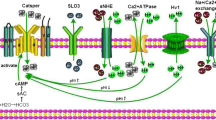Abstract
Low voltage-activated, rapidly inactivating T-type Ca2+ channels are found in a variety of cells, where they regulate electrical activity and Ca2+ entry. In whole-cell patch-clamp recordings from mouse spermatogenic cells, trace element copper (Cu2+) inhibited T-type Ca2+ current (I T-Ca) with IC50 of 12.06 μM. Inhibition of I T-Ca by Cu2+ was concentration-dependent and mildly voltage-dependent. When voltage stepped to −20 mV, Cu2+ (10 μM) inhibited I T-Ca by 49.6 ± 4.1%. Inhibition of I T-Ca by Cu2+ was accompanied by a shift of −2.23 mV in the voltage dependence of steady-state inactivation. Cu2+ upshifted the current–voltage (I-V) curve. To know the change of the gating kinetics of T-type Ca2+ channels, we analyzed the effect of Cu2+ on activation, inactivation, deactivation and reactivation of T-type Ca2+ channels. Since T-type Ca2+ channels are a key component in capacitation and the acrosome reaction, our data suggest that Cu2+ can affect male reproductive function through T-type Ca2+ channels as a preconception contraceptive material.







Similar content being viewed by others
References
Arnoult C, Cadullo RA, Lemos JR, Florman HM (1996) Activation of mouse sperm T-type Ca2+ channels by adhesion to the egg zona pellucida. Proc Natl Acad Sci USA 93:13004–13009
Arnoult C, Villaz M, Florman HM (1998) Pharmacological properties of the T-type Ca2+ current of mouse spermatogenic cells. Mol Pharmacol 53:1104–1111
Bai JP, Shi YL (2002) Inhibition of T-type Ca2+ currents in mouse spermatogenic cells by gossypol, an antifertility compound. Eur J Pharmacol 440:1–6
Chen C, Hess P (1990) Mechanism of gating of T-type calcium channels. J Gen Physiol 96:603–630
Darszon A, Nishigaki T, Wood C, Trevino CL, Felix R, Beltran C (2005) Calcium channels and Ca2+ fluctuations in sperm physiology. Int Rev Cytol 243:79–172
Darszon A, Lopez-Martinez P, Acevedo JJ, Hernandez-Cruz A, Trevino CL (2006) T-type Ca2+ channels in sperm function. Cell Calcium 40:241–252
Ebesh O, Barone A, Harper RG, Wapnir R (1999) Combined effect of high-fat diet and copper deficiency during gestation on fetal copper status in the rat. Biol Trace Elem Res 67:139–150
Espinosa F, Lopez-Gonzalez I, Serrano CJ, Gasque G, De La Vega-Beltran JL, Trevino CL, Darszon A (1999) Anion channel blockers differentially affect T-type Ca2+ currents of mouse spermatogenic cells, a1E currents expressed in Xenopus oocytes and the sperm acrosome reaction. Dev Genet 25:103–114
Espinosa F, Lopez-Gonzalez I, Munoz-Garay C, Felix R, De La Vega-Beltran JL, Kopf GS, Visconti PE, Darszon A (2000) Dual regulation of the T-type Ca2+ current by serum albumin and hestradiol in mammalian spermatogenic cells. FEBS Lett 475:251–256
Hart EB (1928) Copper as a supplement to iron for hemoglobin building in the rat. J Biol Chem 77:797–812
Ho HC, Suarez SS (2003) Characterization of the intracellular calcium store at the base of the sperm flagellum that regulates hyperactivated motility. Biol Reprod 68:1590–1596
Hostetler CE, Kincaid RL, Mirando MA (2003) The role of essential trace elements in embryonic and fetal development in livestock. Vet J 166:125–139
Jeong SW, Park BG, Park JY, Lee JW, Lee JH (2003) Divalent metals differentially block cloned T-type calcium channels. Neuroreport 14:1537–1540
Jungnickel MK, Sutton KA, Florman HM (2003) In the beginning: lessons from fertilization in mice and worms. Cell 114:401–404
Jurasovic J, Telisman S (1993) Determination of lead and cadmium in human seminal fluid by electrothermical atomic absorption spectrometry. J Anal At Spectrom 8:419–425
Lievano A, Santi CM, Serrano CJ, Trevino CL, Bellve AR, Hernandez-Cruz A, Darszon A (1996) T-type Ca2+ channels and a1E expression in spermatogenic cells, and their possible relevance to the sperm acrosome reaction. FEBS Lett 388:150–154
Matteson DR, Armstrong CM (1986) Properties of two types of calcium channels in clonal pituitary cells. J Gen Physiol 87:161–182
Roblero L, Guadarrama A, Lopez T, Zegers-Hochschild F (1996) Effect of copper ion on the motility, viability, acrosome reaction and fertilizing capacity of human spermatozoa in vitro. Reprod Fertil Dev 8:871–874
Santi CM, Darszon A, Hernandez-Cruz A (1996) A dihydropyridine-sensitive T-type Ca2+ current is the main Ca2+ current in mouse primary spermatocytes. Am J Physiol 271:1583–1593
Stamboulian S, Kim D, Shin HS, Ronjat M, De Waard M, Arnoult C (2004) Biophysical and pharmacological characterization of spermatogenic T-type calcium current in mice lacking the CaV3.1 (alpha1G) calcium channel: CaV3.2 (alpha1H) is the main functional calcium channel in wild-type spermatogenic cells. J Cell Physiol 200:116–124
Telisman S, Cvitkovic P, Jurasovic J, Pizent A, Gavella M, Rocic B (2000) Semen quality and reproductive endocrine function in relation to biomarkers of lead, cadmium, zinc, and copper in men. Environ Health Perspect 108:45–53
Thomas JW, Moss S (1951) The effect of orally administered molybdenum on growth spermatogenesis and testes histology of young dairy bulls. J Dairy Sci 34:929–934
Wennemuth G, Wenstenbroek RE, Xu T, Hille B, Babcock DF (2000) CaV2.2 and CaV2.3 (N- and R-type) Ca2+ channels in depolarization-evoked entry of Ca2+ into mouse sperm. J Biol Chem 275:21210–21217
Wong WY, Flik G, Groenen PM, Swinkels DW, Thomas CM, Copius-Peereboom JH, Merkus HM, Steeqers-Theunissen RP (2001) The impact of calcium, magnesium, zinc and copper in blood and seminal plasma on semen parameters in men. Reprod Toxicol 15:131–136
Yanagimachi R (1994) Mammalian fertilization. In: Knobile E, Neill JD (eds) The physiology of reproduction. Raven Press, New York, pp 189–317
Acknowledgements
This work was supported by the National Science Foundation of China (30571555 and 30771831).
Author information
Authors and Affiliations
Corresponding author
Rights and permissions
About this article
Cite this article
Lu, L., Wang, C., Gao, X. et al. Effects of Copper on T-Type Ca2+ Channels in Mouse Spermatogenic Cells. J Membrane Biol 227, 87–94 (2009). https://doi.org/10.1007/s00232-008-9148-y
Received:
Accepted:
Published:
Issue Date:
DOI: https://doi.org/10.1007/s00232-008-9148-y




